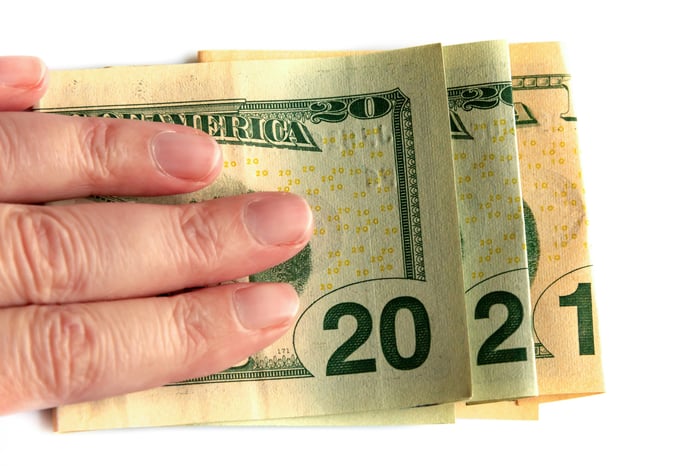One of the wackiest years on record for the stock market is finally coming to a close. From a human perspective, no one is going to be sad to kiss 2020, and hopefully soon the coronavirus pandemic, goodbye. But for investors, it's been a gangbusters sort of year for growth stocks.
As we head into 2021, I'll be counting on the following mix of growth and value plays to power my own portfolio higher.

Image source: Getty Images.
SSR Mining
For more than four years, gold stock SSR Mining (SSRM 0.91%) has been my largest holding. Prior to that, it was Canadian mining company Claude Resources, which SSR acquired in 2016. Over the past eight years, I've only minimally pared down this position, which is up a little over 1,300% from my cost basis.
I'm definitely excited to see what 2021 has in store for my largest holding. The outlook for physical gold has arguably never been more lustrous, with an all-time record $17.05 trillion in global investment-grade debt bearing a negative yield. When coupled with ongoing quantitative easing measures in the U.S., and the prospect of fiscal stimulus, the U.S. dollar should remain under pressure. It's worth bearing in mind that the dollar and gold have an inverse relationship.
Beyond just benefiting from a higher price for gold, SSR Mining recently completed its merger of equals with Turkey's Alacer Gold. This year should yield well over 700,000 gold equivalent ounces of production and north of $450 million in free cash flow.
SSR Mining is also introducing a $0.05 quarterly payout in 2021 and may further boost its capital return program, depending on its cash flow.

Image source: Getty Images.
First Majestic Silver
Similar to SSR Mining, silver stock First Majestic Silver (AG 2.06%) has been my No. 2 holding for years. Initially, I had owned shares of Mexican gold producer Primero Mining but came into my shares of First Majestic via an acquisition of Primero in May 2018.
Though silver doesn't have the same exact tailwinds as gold, it's typically a very strong play within the first 12 to 24 months of an economic recovery. I'll be looking for silver demand to remain strong, especially with the need for silver increasing in the solar and auto industries. Supply and demand economics would suggest a lustrous future lies ahead for silver, as it does for gold.
As for First Majestic, 2021 should be the first time in a long time its bottom line sees marked improvement. In addition to higher realized selling prices, the costs associated with the maintenance of mines will be reduced, while operating efficiency should be on the rise at its three active mines (San Dimas, La Encantada, and Santa Elena). I'm expecting real improvement in the company's efforts to lower all-in sustaining costs in 2021, which will, in part, help First Majestic pay a nominal quarterly dividend.

Image source: Getty Images.
Teva Pharmaceutical Industries
For brand-name and generic-drug manufacturer Teva Pharmaceutical Industries (TEVA 1.85%), it was another rough year. Teva's shares are relatively flat in 2020 after the company faced lawsuits alleging it fixed prices on generic drugs and was a key player in fueling opioid addiction in the U.S. However, I believe my third-largest holding and deep-discount value stock can have a better 2021.
Teva's not-so-secret weapon continues to be its turnaround specialist CEO Kare Schultz. Since taking over in November 2017, Schultz has reduced the company's annual operating expenses by about $3 billion and helped to reduce net debt from north of $34 billion to under $24 billion. By 2023, it's possible Teva's net debt could dip below $15 billion, with a combination of asset sales and operating cash flow used to pay down its debt.
It's also likely that Schultz will help Teva navigate its current cloud of lawsuits. Avoiding cash fines shouldn't be difficult for a company with a monstrously large portfolio of generic treatments. Offering its therapies at a discount over the long run should allow Teva and U.S. regulators to come to an agreement on outstanding lawsuits sooner than later.

Image source: Pinterest.
In the growth department, social media platform Pinterest (PINS -0.64%) climbed from brand-new buy to the No. 4 position in my portfolio in just 10 months. Though it's unlikely we'll see such robust gains in 2021, I'm confident that Pinterest can top a $100 billion valuation, if not much more, before the decade is over.
The Pinterest growth story revolves around two catalysts. First, it's a numbers game that the company is having no trouble winning. Prior to the coronavirus pandemic, Pinterest's monthly active user count was growing by 30% annually between 2017 and 2019. It's picked up even more in 2020 as a significant number of people are staying at home to safeguard their health. But the important aspect of this user growth is that it's primarily coming from international markets. Overseas average revenue per user can be doubled many times over this decade.
The other major catalyst for Pinterest is its burgeoning e-commerce presence. With its users willingly sharing the things, places, and services that interest them, Pinterest can be the platform that connects small businesses to these motivated consumers. It's investing heavily in its platform to keep users engaged and is giving small businesses every chance possible to succeed.

Image source: Getty Images.
Teladoc Health
Rounding out my top portfolio holdings is telemedicine giant Teladoc Health (TDOC -2.91%) in the number five slot. I initially purchased Applied Health Signals company Livongo Health in March but came into my Teladoc shares following the buyout of Livongo.
Similar to Pinterest, Teladoc was a no-brainer beneficiary of the coronavirus pandemic. Physicians wanting to keep potentially infected and at-risk people out of offices have turned in greater numbers to virtual visits with their patients. In each of the past two quarters, Teladoc's virtual visit count has more than tripled from the prior-year period. With telehealth more convenient for patients and doctors, and generally cheaper for health insurers, demand is only going to increase going forward.
The acquisition of Livongo Health is also going to pay big-time dividends. I purchased Livongo because I was excited about its potential to sign up people with chronic health conditions. Despite holding less than a 1% share of the U.S. diabetes market, Livongo had already turned profitable on a recurring basis prior to its acquisition. Now, with Livongo's ability to cross-sell solutions with Teladoc, I view the sky as the limit.





